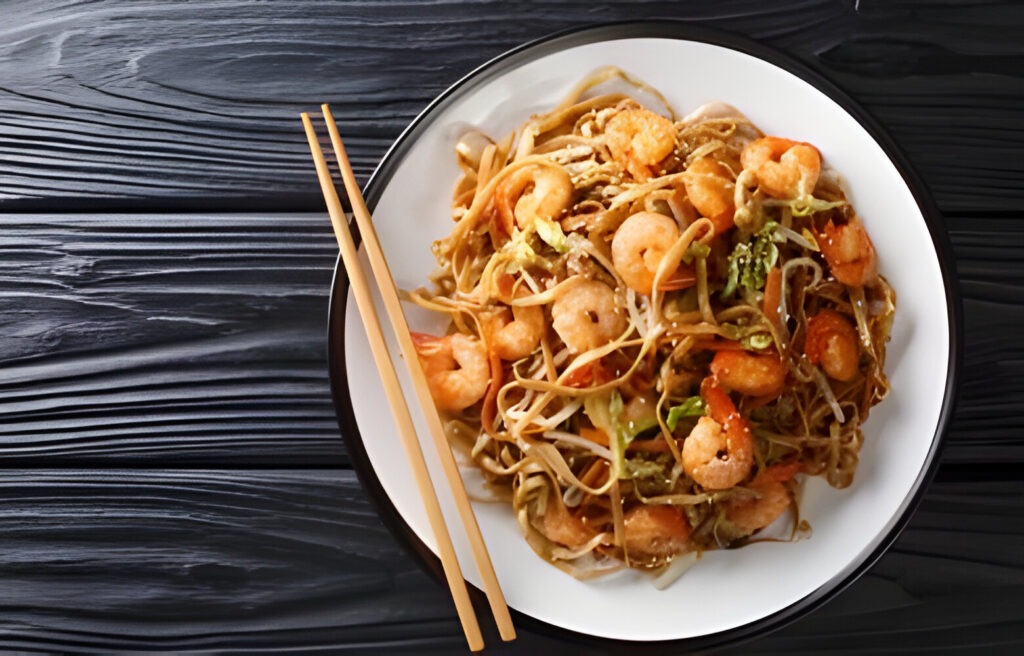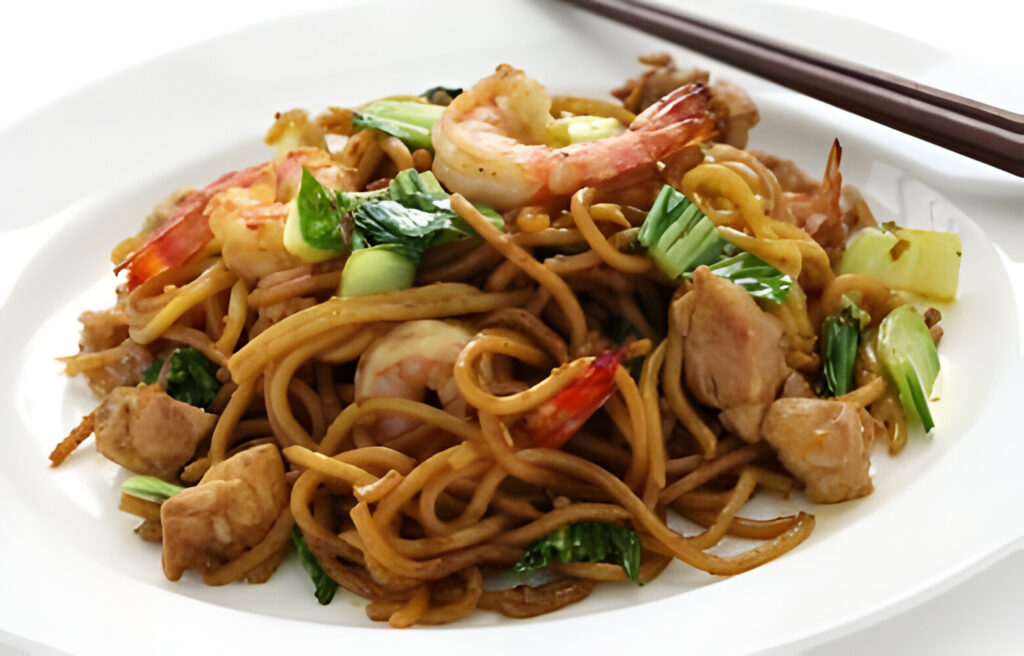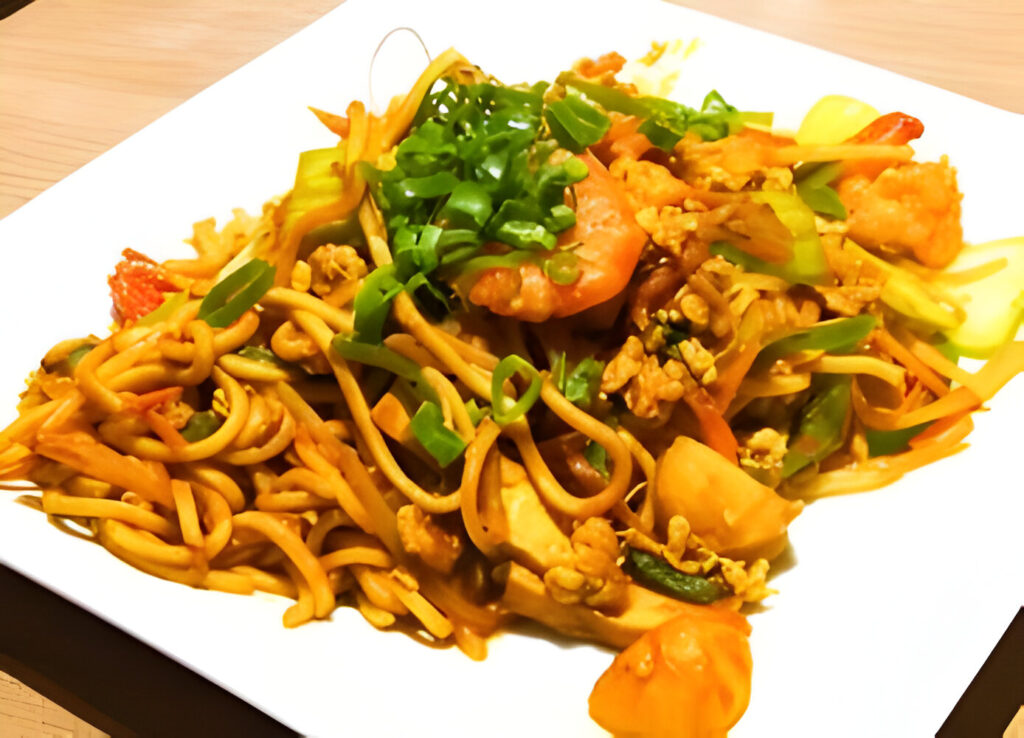
Introduction to Shrimp Chow Mein
Shrimp chow mein stands as a celebrated dish in the realm of Chinese cuisine, captivating food enthusiasts worldwide. This dish, known for its savory flavors and satisfying texture, seamlessly blends the richness of shrimp with the crunch of fresh vegetables, all intertwined with perfectly cooked noodles. Let’s embark on a journey to discover the essence of shrimp chow mein, its origins, and what makes it a global favorite.
The Allure of Shrimp Chow Mein
Shrimp chow mein has garnered fame for its versatility and delightful taste. It serves not only as a staple in Chinese restaurants across the globe but also as a favorite among home cooks seeking to recreate the magic of authentic Chinese cuisine in their kitchens. The combination of succulent shrimp and crispy vegetables, tossed with hearty noodles in a flavorful sauce, makes it a dish that appeals to a wide audience. Its popularity underscores the global love affair with Chinese culinary traditions, showcasing the universal appeal of well-crafted noodle dishes.
A Brief Stroll Through History
The origins of chow mein trace back to the northern regions of China, evolving significantly as it traveled across continents. Adapted to suit local tastes and available ingredients, chow mein has witnessed countless variations, each adding a unique twist to the original recipe. The term “chow mein” itself, meaning “stir-fried noodles” in Cantonese, hints at the cooking technique that is central to its preparation. This historical journey from humble beginnings to global fame highlights the dish’s adaptability and enduring appeal.
What Awaits You
In this article, readers will dive deep into the world of shrimp chow mein. From uncovering its nutritional benefits to exploring a step-by-step recipe, we’ll cover all you need to know to master this dish. Expect to find useful cooking tips, ingredient substitutions for dietary needs, and creative variations to personalize your chow mein. Whether you’re a seasoned chef or a curious newcomer to Chinese cuisine, this guide aims to equip you with the knowledge to prepare and enjoy an authentic shrimp chow mein experience.
By focusing on shrimp chow mein, we celebrate not just a dish but a cultural phenomenon that bridges continents and cuisines. Stay tuned as we delve into the nutritional landscape of shrimp chow mein, highlighting how this delightful dish can fit into a balanced diet.
The Nutritional Value of Shrimp Chow Mein
Shrimp chow mein isn’t just a feast for the senses; it’s also a dish that packs a nutritional punch. This section delves into the health benefits of its key components: shrimp, vegetables, and noodles. Understanding the nutritional content can help you enjoy this delicious dish while maintaining a balanced diet.
The Health Benefits of Shrimp
Shrimp, the star ingredient of chow mein, is more than just a flavorful addition. It’s a fantastic source of high-quality protein, essential for muscle building and repair. Additionally, shrimp is low in calories yet rich in omega-3 fatty acids, promoting heart health and brain function. It also boasts a good amount of selenium, a powerful antioxidant that combats inflammation and supports the immune system. Including shrimp in your diet offers a delicious way to benefit from these health-boosting nutrients.
Vegetables: A Crunchy Nutrient Powerhouse
The array of vegetables in shrimp chow mein adds not only texture and color but also a significant nutritional boost. Commonly used vegetables like bell peppers, carrots, and cabbage are rich in vitamins A and C, fiber, and antioxidants. These nutrients aid in vision health, skin integrity, and digestion, while also lowering the risk of chronic diseases. By incorporating a generous serving of vegetables, shrimp chow mein becomes a balanced dish that contributes to your daily vegetable intake.
Noodles and Sauce: Balancing Taste and Nutrition
While noodles are the base of chow mein, choosing the right type can influence the dish’s nutritional profile. Whole grain or high-fiber noodles are excellent alternatives to traditional white noodles, offering more nutrients and aiding in digestion. The sauce, albeit flavorful, should be used judiciously to control sodium intake. Opting for low-sodium soy sauce and adding spices for extra flavor can make your shrimp chow mein healthier without compromising taste.
Crafting a Balanced Dish
To make shrimp chow mein a part of a well-rounded diet, consider the proportions of each ingredient. A good rule of thumb is to prioritize vegetables, making them half of the dish, followed by protein (shrimp), and then noodles. This balance ensures a nutrient-dense meal that satisfies without overindulgence. Moreover, for those monitoring calorie intake or dietary restrictions, simple swaps and adjustments can transform chow mein into a meal that fits various health goals.
Embracing chow mein as a nutritious option is easy when you’re aware of the benefits each component brings to the table. This dish is a testament to the possibility of combining delectable flavors with healthful eating. Next, we’ll explore the essential ingredients and substitutes that can make shrimp chow mein a staple in your culinary repertoire.
Essential Ingredients and Substitutes for Chow Mein
Mastering shrimp chow mein starts with understanding its essential ingredients. However, dietary preferences and restrictions often necessitate substitutes. This section provides a comprehensive guide to both, ensuring everyone can enjoy this classic dish.
Key Ingredients for Authentic Flavor
The foundation of chow mein lies in its carefully selected ingredients, each contributing to its distinctive taste and texture.
- Shrimp: Opt for fresh or frozen shrimp. Size matters for texture and presentation, so medium to large shrimp is ideal.
- Noodles: Traditional chow mein uses wheat-based noodles. For the best results, look for noodles labeled specifically for chow mein or stir-fry.
- Vegetables: A mix of cabbage, carrots, and bell peppers introduces color, crunch, and nutrition. Feel free to add or substitute with snow peas, bean sprouts, or bok choy for variety.
- Sauce: A combination of soy sauce, oyster sauce, sesame oil, and a touch of sugar balances savory, sweet, and umami flavors.
Substitutes to Accommodate Dietary Needs
Dietary restrictions shouldn’t keep anyone from enjoying chow mein. Fortunately, numerous substitutes can accommodate various needs.
- For Gluten Sensitivity: Substitute wheat noodles with rice noodles or gluten-free alternatives. Also, use tamari instead of traditional soy sauce.
- For Shellfish Allergies: Replace shrimp with chicken, beef, or tofu to maintain the protein content without risking allergies.
- Vegetarian and Vegan Options: Omit shrimp and enhance the dish with tofu or tempeh. Ensure all sauces are vegan-friendly by reading labels carefully.
Ingredient Spotlight: Quality Matters
The secret to a memorable chow mein lies in the quality of its ingredients. Fresh, high-quality shrimp significantly impact flavor and texture. Similarly, fresh vegetables, rather than pre-packaged mixes, add a vibrant crunch that defines the dish. When selecting noodles, choosing the right type can make a difference in achieving the authentic chow mein texture.
Navigating Dietary Restrictions with Ease
Understanding the role of each ingredient in chow mein allows for thoughtful substitutions that maintain the dish’s integrity. Whether accommodating dietary preferences or working with available ingredients, the versatility of chow mein ensures it remains a beloved dish for all.
Next, we’ll walk through a detailed, step-by-step recipe to bring the authentic taste of shrimp chow mein right to your kitchen. With these ingredients and substitutes in hand, creating a delicious, inclusive meal has never been easier.

Step-by-Step Recipe for Chow Mein
Crafting the perfect chow mein requires attention to detail and a step-by-step approach. This recipe breaks down the process into manageable stages, ensuring a flavorful and satisfying dish. Whether you’re a seasoned cook or new to the kitchen, follow these instructions for a successful chow mein.
Preparing Your Ingredients
- Shrimp Preparation: Start by cleaning and deveining the shrimp. If you’re using frozen shrimp, ensure they’re fully thawed. A quick marinade in a mixture of soy sauce and a dash of sesame oil can enhance the shrimp’s flavor. Set aside for 15 minutes.
- Vegetable Prep: Wash and chop your vegetables. Thinly slice cabbage, julienne carrots, and cut bell peppers into strips. Uniformity in size ensures even cooking.
- Noodle Prep: Cook the noodles according to package instructions, but slightly undercook them by 1-2 minutes. They’ll continue cooking when stir-fried. Rinse under cold water to stop the cooking process and prevent sticking.
Cooking the Chow Mein
- Heat the Wok: Start by heating a tablespoon of oil in a large wok or frying pan over high heat. The key to stir-frying is keeping the ingredients moving, so have everything prepped and within reach.
- Cook the Shrimp: Add the marinated shrimp to the wok. Cook until they turn pink and opaque, about 2-3 minutes. Remove and set aside.
- Vegetables Next: In the same wok, add another tablespoon of oil if needed. Stir-fry the vegetables until they’re just tender but still crisp, about 3-4 minutes.
- Combine with Noodles: Add the cooked noodles to the wok, along with the shrimp. Pour in the sauce mixture of soy sauce, oyster sauce, and a splash of water to help distribute the sauce evenly.
- Final Toss: Stir everything together in the wok, ensuring the noodles, vegetables, and shrimp are well-coated in the sauce. Cook for an additional 2 minutes, allowing the flavors to meld.
Finishing Touches
- Serve Hot: chow mein is best enjoyed fresh from the wok. Serve it hot, garnished with a sprinkle of sesame seeds or chopped green onions for an extra layer of flavor and texture.
- Adjust Seasonings: Taste your chow mein before serving. Adjust the seasoning with a little more soy sauce or a dash of sesame oil if needed.
Recipe Tips for Success
- High Heat Is Key: High heat keeps the ingredients sizzling, preventing them from releasing too much moisture and becoming soggy.
- Prep Ahead: Having all your ingredients prepared and within reach makes the cooking process smooth and efficient.
- Variety in Texture: The contrast between the soft noodles, crisp vegetables, and tender shrimp is what makes chow mein delightful. Aim for a variety of textures.
Following these detailed steps will help you create a delicious shrimp that’s full of flavor and texture. Enjoy the process and the delicious results!
Tips and Tricks for the Perfect Chow Mein
Achieving the perfect chow mein involves more than just following a recipe. It’s about mastering the nuances that elevate your dish from good to great. Here, we’ll share expert tips and common mistakes to avoid, ensuring your chow mein stands out.
Cooking Techniques to Master
- High Heat Stir-Frying: The essence of a great chow mein lies in the stir-fry technique. Use high heat to cook quickly and retain the freshness of your ingredients. This method seals in flavors and textures, making each bite a delight.
- Avoid Overcrowding: Cooking in batches may be necessary to prevent overcrowding in your wok or pan. Overcrowding leads to steaming rather than stir-frying, resulting in soggy vegetables and rubbery shrimp.
- Proper Wok Tossing: Learn the art of tossing your ingredients in the wok. It ensures even cooking and flavor distribution without breaking the delicate noodles or shrimp.
Serving Suggestions for Enhanced Experience
- Presentation Matters: Serve your shrimp chow mein in a large, shallow bowl or on a platter to showcase its vibrant colors and textures. A garnish of green onions or a sprinkle of sesame seeds adds visual appeal.
- Pair with Complementary Dishes: For a complete meal, serve chow mein alongside other Chinese dishes like dim sum, spring rolls, or a simple cucumber salad. The variety adds to the dining experience.
Common Mistakes to Avoid
- Not Prepping Ingredients Ahead: The fast pace of stir-frying means there’s no time to chop vegetables or measure sauces during cooking. Prep everything before you start.
- Skipping the Marinade: Marinating the shrimp, even briefly, infuses it with flavor. Don’t skip this step, as it makes a noticeable difference.
- Using Wet Noodles: Ensure your noodles are well-drained before adding them to the wok. Excess water can make the dish too soggy.
By incorporating these tips into your cooking, you’ll find that making chow mein becomes an enjoyable and successful endeavor. Remember, the beauty of cooking lies in experimentation and tweaking recipes to suit your taste. So, don’t be afraid to make this dish your own.
Variations and Serving Ideas for Chow Mein
Shrimp chow mein, with its rich flavors and diverse textures, offers a canvas for creativity. This final part explores variations and serving suggestions to elevate your chow mein experience. Experimenting with different ingredients and presentation styles can turn this classic dish into a personalized culinary masterpiece.
Exploring Regional Variations
Shrimp chow mein adapts beautifully to different regional influences, allowing for a fusion of flavors that can cater to any palate.
- Spicy Sichuan Version: Introduce a spicy twist with Sichuan peppercorns and chili oil for those who love a bit of heat.
- Singapore-Style: Incorporate curry powder for a Singaporean flair, adding a unique aroma and taste to the traditional recipe.
- Thai-Inspired: Add a splash of fish sauce and a hint of lime juice for a Thai version, creating a perfect balance of salty, sweet, and sour.
Creative Twists for Personalization
- Vegetable Variety: Don’t hesitate to use whatever vegetables you have on hand. Broccoli, snap peas, and mushrooms make great additions.
- Protein Swap: While shrimp is the star, feel free to substitute or add other proteins like diced chicken, beef strips, or tofu for a vegetarian option.
- Noodle Alternatives: For a low-carb version, zucchini noodles or spaghetti squash can replace traditional noodles without compromising the dish’s essence.
Serving Ideas to Impress
- Complementary Dishes: Serve shrimp chow mein alongside other Chinese favorites like egg rolls, dumplings, or a simple cucumber salad for a complete meal.
- Plating Techniques: Serve in a large, shallow bowl to showcase the colorful mix of ingredients. A sprinkle of freshly chopped green onions or a few sprigs of cilantro can add a fresh pop of color.
- Pair with Rice: For those who prefer a mix of textures, serving chow mein with a side of steamed jasmine rice offers a delightful contrast.
Conclusion
Shrimp chow mein is more than just a dish; it’s a journey through flavors, textures, and culinary creativity. By exploring variations and embracing serving suggestions, you can tailor this classic dish to fit any occasion or dietary preference. Whether you’re cooking for a weeknight dinner or a special gathering, shrimp chow mein is sure to impress with its versatility and deliciousness.

Frequently Asked Questions About Chow Mein
Shrimp chow mein, with its rich flavors and diverse textures, often sparks curiosity and questions among enthusiasts of Chinese cuisine. Below, we address some of the most common inquiries, providing detailed answers to enhance your cooking experience and knowledge about this beloved dish.
What Type of Noodles Are Best for Shrimp Chow Mein?
The ideal choice for authentic shrimp chow mein are thin, wheat-based noodles, sometimes specifically labeled as “chow mein noodles.” These noodles offer the perfect texture when stir-fried, turning slightly crispy on the outside while remaining tender on the inside. For those seeking gluten-free options, rice noodles or gluten-free spaghetti can serve as excellent substitutes without compromising the dish’s integrity.
Can I Make Shrimp Chow Mein Without a Wok?
Yes, you can still create delicious shrimp chow mein without a wok. Opt for a large, non-stick frying pan with enough space to comfortably stir and toss the ingredients. The key is to maintain high heat and cook the ingredients in batches if necessary, ensuring each component has enough room to achieve the desired texture.
How Do I Prevent My Noodles from Sticking Together?
To prevent noodles from sticking, cook them until they’re just underdone, then rinse under cold water to halt the cooking process immediately. Toss them with a teaspoon of oil before adding them to the wok. This extra step keeps the noodles loose and prevents clumping, ensuring each strand is evenly coated with sauce and integrated with the other ingredients.
What Vegetables Can I Use in Shrimp Chow Mein?
Shrimp chow mein is incredibly versatile when it comes to vegetables. While cabbage, carrots, and bell peppers are traditional, feel free to incorporate snow peas, bean sprouts, bok choy, or broccoli. The aim is to include a variety of textures and colors, enhancing the dish’s nutritional value and visual appeal.
How Can I Adjust the Recipe to Make It Healthier?
To make shrimp chow mein healthier, consider using whole grain or high-fiber noodles and increasing the proportion of vegetables to noodles and shrimp. Opt for low-sodium soy sauce to reduce sodium intake and increase the use of spices and herbs for flavor. Additionally, lean towards cooking methods that require less oil, such as using a non-stick pan or slightly reducing the amount of oil called for in the recipe.
Can Shrimp Chow Mein Be Made in Advance?
Shrimp chow mein is best enjoyed fresh, as the noodles can become soft and the vegetables may lose their crispness when reheated. However, you can prepare the ingredients in advance, such as chopping the vegetables and marinating the shrimp. This prep work allows for a quick and easy assembly when you’re ready to cook, ensuring the dish retains its optimal texture and flavor.
Is Shrimp Chow Mein Suitable for Freezing?
It is not recommended to freeze shrimp chow mein. Freezing can significantly alter the texture of the noodles and vegetables, leading to a less desirable outcome upon reheating. For the best experience, enjoy shrimp chow mein freshly made, relishing the vibrant textures and flavors that make it a standout dish.